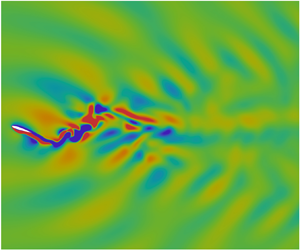Published online by Cambridge University Press: 08 February 2024

We investigate numerically the propulsion characteristics of an oscillating foil undergoing coupled heave and pitch motion in a linearly density-stratified flow. A parameter space defined by the internal Froude number ( $1 \le Fr \le 10$) and the maximum angle of attack (
$1 \le Fr \le 10$) and the maximum angle of attack ( $5^\circ \le {\alpha _0} \le 30^\circ$) is considered in our study. The results demonstrate a significant enhancement in both thrust production and propulsive efficiency due to the stratification influence. Notably, the highest efficiency exceeding
$5^\circ \le {\alpha _0} \le 30^\circ$) is considered in our study. The results demonstrate a significant enhancement in both thrust production and propulsive efficiency due to the stratification influence. Notably, the highest efficiency exceeding  $80\,\%$ is achieved under moderate stratification conditions, surpassing the performance observed in a homogeneous fluid. We attribute this optimum performance to the proper match between the stratification effect and foil kinematics, which gives rise to intense vortex interactions and sufficient wave–mean flow interactions in the near wake of the oscillating foil. Consequently, the energy is transferred towards wake structures to form a high-intensity momentum jet in close proximity to the foil's trailing edge, indicating efficient propulsion. Furthermore, we find that the stratifications within the moderate-to-strong transitional regime display a reduced dependence of propulsive efficiency on the maximum angle of attack, primarily due to the delaying and alleviating effects on dynamic-stall events. Such a mechanism enables the oscillating foil to maintain a satisfactory performance by sufficiently high angles of attack without the penalty of stall events. Based on our findings, we propose that animals or artificial vehicles utilising oscillatory propulsion can benefit from the presence of density stratification in the surrounding fluid.
$80\,\%$ is achieved under moderate stratification conditions, surpassing the performance observed in a homogeneous fluid. We attribute this optimum performance to the proper match between the stratification effect and foil kinematics, which gives rise to intense vortex interactions and sufficient wave–mean flow interactions in the near wake of the oscillating foil. Consequently, the energy is transferred towards wake structures to form a high-intensity momentum jet in close proximity to the foil's trailing edge, indicating efficient propulsion. Furthermore, we find that the stratifications within the moderate-to-strong transitional regime display a reduced dependence of propulsive efficiency on the maximum angle of attack, primarily due to the delaying and alleviating effects on dynamic-stall events. Such a mechanism enables the oscillating foil to maintain a satisfactory performance by sufficiently high angles of attack without the penalty of stall events. Based on our findings, we propose that animals or artificial vehicles utilising oscillatory propulsion can benefit from the presence of density stratification in the surrounding fluid.